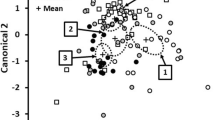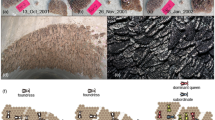Abstract
Spatial behaviour of colony members within a nest represents an essential aspect of colony organization. However, little attention has been devoted to the study of this aspect in social insects. A recent study based on a single day of observation showed that colony members of the paper wasp Polistes dominula were spatially arranged on the comb in a predictable way. Alpha females patrolled a small central area of the comb, while subordinates and workers were mostly active in the nest periphery. The present study investigated the existence of a spatial–temporal polyethism in P. dominula by studying whether workers and foundresses change their within-nest spatial behaviour over their lifespan. The results showed that while the age of a worker weakly influenced the probability that she performed a within-nest task or foraged outside, it did not account for any aspect of the wasp’s within-nest spatial behaviour. Precisely, the size of the patrolled area, the position on the comb, and the rate of superimposition with other nestmates were all not related to the age of the wasp. Moreover, no evident spatial segregation between young and old individuals occurred on the comb. These findings suggest that other proximate mechanisms underlie the observed colony spatial organization. As the reproductive division of labour was the only factor affecting wasp spatial sorting within the nest, dominance hierarchy and social interactions between and within foundress and workers represent good candidates responsible for the colony’s spatial organization.





Similar content being viewed by others
References
Backen SJ, Sendova-Franks AB, Franks NR (2000) Testing the limits of social resilience in ant colonies. Behav Ecol Sociobiol 48(2):125–131
Bakar NAA, Baracchi D, Turillazzi S (2016) Reuse of old nests by the European paper wasp Polistes dominula (Hymenoptera Vespidae). REDIA 98(1):21–24
Baracchi D, Cini A (2014) A socio-spatial combined approach confirms a highly compartmentalised structure in honeybees. Ethology 120(12):1167–1176
Baracchi D, Hashim R, Teseo S, Turillazzi S (2009) Basic social biology and nest architecture of Liostenogaster topographica Turillazzi 1999 (Hymenoptera Stenogastrinae). Trop Zool 22(1):15–25
Baracchi D, Turillazzi S, Cervo R (2007) Preliminary investigation on Polistes dominulus workers’ spatial distribution the nest in relation to immature brood position. REDIA 90:139–142
Baracchi D, Zaccaroni M, Cervo R, Turillazzi S (2010) Home range analysis in the study of spatial organization on the comb in the paper wasp Polistes dominulus. Ethology 116(7):579–587
Beshers SN, Fewell JH (2001) Models of division of labor in social insects. Annu Rev Entomol 46(1):413–440
Bonabeau E, Dorigo M, Theraulaz G (1999) Swarm intelligence: from natural to artificial systems. Oxford University Press, New York
Calderone NW, Page RE (1988) Genotypic variability in age polyethism and task specialization in the honey bee, Apis mellifera (Hymenoptera: Apidae). Behav Ecol Sociobiol 22(1):17–25
Camazine S (1991) Self-organizing pattern formation on the combs of honey bee colonies. Behav Ecol Sociobiol 28(1):61–76
Costa JT (2006) The other insect societies. Harvard University Press, Cambridge, MA
Franks NR, Tofts C (1994) Foraging for work: how tasks allocate workers. Anim Behav 48:470–472
Hart AG, Ratnieks FL (2001) Task partitioning, division of labour and nest compartmentalisation collectively isolate hazardous waste in the leafcutting ant Atta cephalotes. Behav Ecol Sociobiol 49(5):387–392
Hughes CR, Strassmann JE (1988) Age is more important than size in determining dominance among workers in the primitively eusocial wasp, Polistes instabilis. Behaviour 107(1):1–14
Jandt J, Tibbetts E, Toth A (2014) Polistes paper wasps: a model genus for the study of social dominance hierarchies. Insect Soc 61(1):11–27
Jandt JM, Dornhaus A (2009) Spatial organization and division of labour in the bumblebee Bombus impatiens. Anim Behav 77(3):641–651
Jandt JM, Thomson JL, Geffre AC, Toth AL (2015) Lab rearing environment perturbs social traits: a case study with Polistes wasps. Behav Ecol 26(5):1274–1284
Jeanne R (1991) Polyethism in social wasps. The Social Biology of Wasps. Comell University Press, Ithaca, NY, pp 389–425
Jeanne RL, Williams NM, Yandell BS (1992) Age polyethism and defense in a tropical social wasp (Hymenoptera: Vespidae). J Insect Behav 5(2):211–227
Krause J, Ruxton GD (2002) Living in groups. OUP, Oxford
Korb J, Heinze J (2016) Major hurdles for the evolution of sociality. Annu Rev Entomol 61:297–316
Leadbeater E, Carruthers JM, Green JP, Rosser NS, Field J (2011) Nest inheritance is the missing source of direct fitness in a primitively eusocial insect. Science 333(6044):874–876
Lindauer M (1952) Ein beitrag zur frage der arbeitsteilung im bienenstaat. Zeitschrift für vergleichende Physiologie 34(4):299–345
Mersch DP, Crespi A, Keller L (2013) Tracking individuals shows spatial fidelity is a key regulator of ant social organization. Science 340(6136):1090–1093
Naug D, Gadagkar R (1998) The role of age in temporal polyethism in a primitively eusocial wasp. Behav Ecol Sociobiol 42(1):37–47
Oster GF, Wilson EO (1978) Caste and ecology in the social insects. Princeton University Press, Princeton, New Jersey
Pardi L (1948) Dominance order in Polistes wasps. Physiol Zool 21(1):1–13
Powell S, Tschinkel WR (1999) Ritualized conflict in Odontomachus brunneus and the generation of interaction-based task allocation: a new organizational mechanism in ants. Anim Behav 58(5):965–972
Pratte M (1989) Foundress association in the paper wasp Polistes dominulus Christ.(Hymen. Vesp.). Effects of dominance hierarchy on the division of labour. Behaviour 111(1):208–219
Queller DC, Strassmann JE (1998) Kin selection and social insects. Bioscience 48(3):165–175
Queller DC, Zacchi F, Cervo R, Turillazzi S, Henshaw MT, Santorelli LA, Strassmann JE (2000) Unrelated helpers in a social insect. Nature 405(6788):784–787
Robinson GE (1992) Regulation of division of labor in insect societies. Annu Rev Entomol 37(1):637–665
Robson S, Bean K, Hansen J, Norling K, Rowe R, White D (2000) Social and spatial organisation in colonies of a primitively eusocial wasp, Ropalidia revolutionalis (de Saussure) (Hymenoptera: Vespidae). Aust J Entomol 39(1):20–24
Seeley TD (1982) Adaptive significance of the age polyethism schedule in honeybee colonies. Behav Ecol Sociobiol 11(4):287–293
Seid MA, Traniello JF (2006) Age-related repertoire expansion and division of labor in Pheidole dentata (Hymenoptera: Formicidae): a new perspective on temporal polyethism and behavioral plasticity in ants. Behav Ecol Sociobiol 60(5):631–644
Sendova-Franks A, Franks NR (1995) Spatial relationships within nests of the ant Leptothorax unifasciatus (Latr.) and their implications for the division of labour. Animl Behav 50(1):121–136
Sendova-Franks A, Franks NR (1993) Task allocation in ant colonies within variable environments (a study of temporal polyethism: experimental). Bull Math Biol 55(1):75–96
Shorter JR, Tibbetts EA (2009) The effect of juvenile hormone on temporal polyethism in the paper wasp Polistes dominulus. Insect Soc 56(1):7–13
Smith CR, Toth AL, Suarez AV, Robinson GE (2008) Genetic and genomic analyses of the division of labour in insect societies. Nat Rev Genet 9(10):735–748
Szathmáry E, Smith JM (1995) The major evolutionary transitions. Nature 374(6519):227–232
Theraulaz G, Bonabeau E, Denuebourg J (1998) Response threshold reinforcements and division of labour in insect societies. Proc R Soc Lond Biol Sci 265(1393):327–332
Theraulaz G, Pratte M, Gervet J (1990) Behavioural profiles in Polistes dominulus (Christ) wasp societies: a quantitative study. Behaviour 113(3):223–249
Tofts C, Franks NR (1992) Doing the right thing: ants, honeybees and naked mole-rats. Trend Ecol Evol 7(10):346–349
Traniello JF, Rosengaus RB (1997) Ecology, evolution and division of labour in social insects. Anim Behav 53(1):209–213
Tsuchida K (1991) Temporal behavioral variation and division of labor among workers in the primitively eusocial wasp, Polistes jadwigae Dalla Torre. J Ethol 9(2):129–134
Turillazzi S, Pardi L (1977) Body size and hierarchy in polygynic nests of Polistes gallicus (L.)(Hymenoptera Vespidae). Ital J Zool 11(1–2):101–112
Wilson EO (1971) The insect societies. Harvard University Press, Cambridge, MA
Wilson EO (1976) Behavioral discretization and the number of castes in an ant species. Behav Ecol Sociobiol 1(2):141–154
Wilson EO (1985) The sociogenesis of insect colonies. Science (Washington) 228(4707):1489–1495
Worton BJ (1989) Kernel methods for estimating the utilization distribution in home-range studies. Ecology 70(1):164–168
Acknowledgements
The author thank Prof. Stefano Turillazzi (Università degli Studi di Firenze) for providing facilities and the team ‘Gruppo Vespe di Firenze’ for his support. The author also thank three anonymous reviewers for their constructive comments and suggestions. At the time of writing of the manuscript, the author was supported by a Marie Curie Intra European Fellowship.
Author information
Authors and Affiliations
Rights and permissions
About this article
Cite this article
Baracchi, D. The reproductive division of labour but not worker age affects spatial sorting within the nest in a paper wasp. Insect. Soc. 64, 379–385 (2017). https://doi.org/10.1007/s00040-017-0557-8
Received:
Revised:
Accepted:
Published:
Issue Date:
DOI: https://doi.org/10.1007/s00040-017-0557-8




